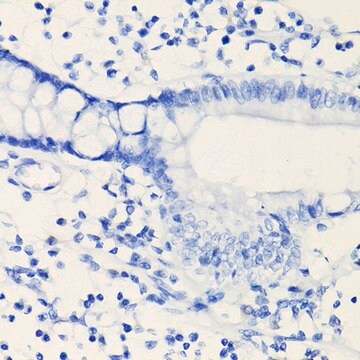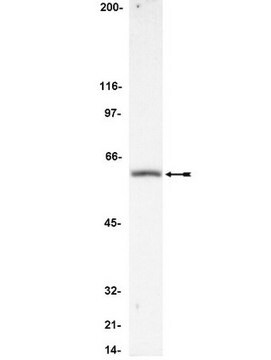06-501
Anti-STAT1 Antibody, CT
Upstate®, from rabbit
Sinônimo(s):
Anti-CANDF7, Anti-IMD31A, Anti-IMD31B, Anti-IMD31C, Anti-ISGF-3, Anti-STAT91
About This Item
Produtos recomendados
fonte biológica
rabbit
Nível de qualidade
forma do anticorpo
purified antibody
tipo de produto de anticorpo
primary antibodies
clone
polyclonal
reatividade de espécies
mouse, human
fabricante/nome comercial
Upstate®
técnica(s)
electrophoretic mobility shift assay: suitable
immunoprecipitation (IP): suitable
western blot: suitable
Isotipo
IgG
nº de adesão NCBI
nº de adesão UniProt
Condições de expedição
wet ice
modificação pós-traducional do alvo
unmodified
Informações sobre genes
human ... STAT1(6772)
Descrição geral
STAT 1, is activated by a number of different ligands, including IFNalpha, IFNgamma, EGF, PDGF and IL6. Phosphorylation of tyrosine 701 is required for STAT 1 dissociation from IFNGR1, homodimerization, and nuclear translocation. Tyrosine 701 phosphorylation impairment results in loss of STAT 1 functions.
Especificidade
Imunogênio
Aplicação
Qualidade
Descrição-alvo
forma física
Nota de análise
Positive Antigen Control: Catalog #12-303, Jurkat cell lysate.
Outras notas
Informações legais
Não está encontrando o produto certo?
Experimente o nosso Ferramenta de seleção de produtos.
recomendado
Código de classe de armazenamento
12 - Non Combustible Liquids
Classe de risco de água (WGK)
WGK 1
Ponto de fulgor (°F)
Not applicable
Ponto de fulgor (°C)
Not applicable
Certificados de análise (COA)
Busque Certificados de análise (COA) digitando o Número do Lote do produto. Os números de lote e remessa podem ser encontrados no rótulo de um produto após a palavra “Lot” ou “Batch”.
Já possui este produto?
Encontre a documentação dos produtos que você adquiriu recentemente na biblioteca de documentos.
Nossa equipe de cientistas tem experiência em todas as áreas de pesquisa, incluindo Life Sciences, ciência de materiais, síntese química, cromatografia, química analítica e muitas outras.
Entre em contato com a assistência técnica







